Gardeners face many challenges. The need to screen neighboring houses is a common one in smaller urban lots and is typically addressed with a 6-foot-tall fence or a row of arborvitae or similar columnar trees. But this situation can be an opportunity to turn a problem area into a garden highlight. Rather then build a barricade, add layers of deciduous and evergreen trees and shrubs, then accent them with seasonal color for a beautiful focal point you will
want to look at.
In rural gardens deer can cause considerable damage and try the patience of even the most wildlife-loving gardener. The first approach is to select plants that are generally considered deer resistant. I have also found that this sort of barrier planting can keep the deer away from some plants that might otherwise be considered caviar. Dense layers seem to require too much effort for the deer to penetrate, and they wander elsewhere to search for their treats.
The beautiful planting combination below will thrive in full sun, average soil and a temperate climate, and is composed of deer-resistant plantings. Since the hardiness zones are given for each plant, look for similar substitutes if one of these falls outside your range. Simply follow these principles to create beauty despite the beast.
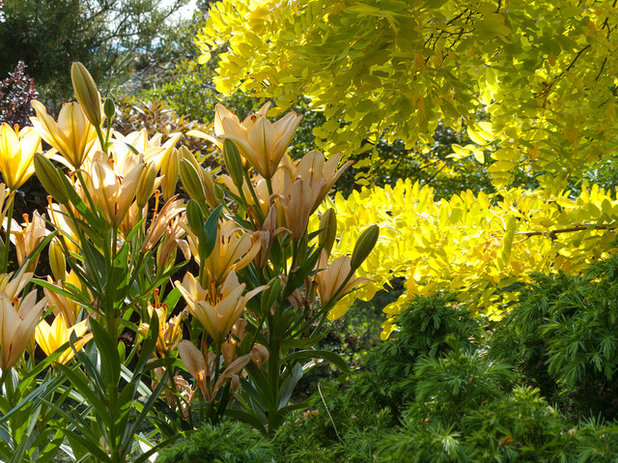
Le jardinet
The best screens are those that don't seem to be screens at all; this is a perfect example. Layers of deciduous, evergreen and seasonal color make this an eye-catching combination whether it's used to create some privacy, keep deer at bay or simply capture interest as a striking vignette.
This soothing monochromatic scheme relies on varying foliage textures and forms for interest. A canopy of
golden locust tree (
Robinia pseudoacacia 'Frisia') leaves rustles in the breeze, towering over
dwarf Japanese cedar (
Cryptomeria japonica 'Elegans Nana'), while a strong vertical accent provided by fragrant lilies
(Lillium 'African Queen') fills in the middle plane.
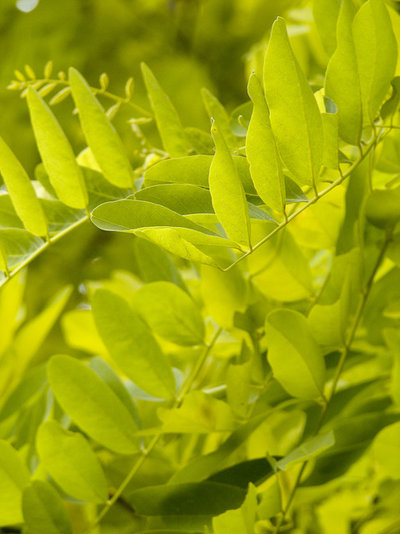
Le jardinet
How to Get the Look
1. Start with the showstopper.Golden locust tree (
Robinia pseudoacacia 'Frisia')
is once seen, never forgotten; this is a tree that will always be on your favorites list.
You have only to stand under the golden canopy of translucent foliage to feel bathed in sunshine even on a cloudy day.
This fast-growing deciduous tree is shunned by deer, thanks to the thorns along the branches. It has fragrant white flowers in spring, although they are somewhat hidden by the foliage, and it is remarkably tolerant of poor soils. Perhaps its main drawback is that the branches are brittle and can break in strong winds, so planting it in a somewhat protected area is advised.
USDA zones: 4 to 9 (find your zone)
Water requirement: Low once established
Light requirement: Full sun for best color
Mature size: 30 to 50 feet tall and up to 20 feet wide
When to plant: Plant it in well-drained soil in spring or fall.
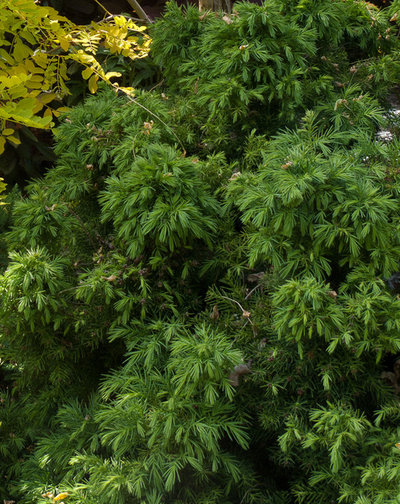
Le jardinet
2. Add a dense lower tier.Dwarf Japanese cedar (
Cryptomeria japonica 'Elegans Nana') always reminds me of a fat little dumpling. It has a rather loose mounding shape and a soft, feathery texture.
I love evergreens that change in some way during the year; this one does that nicely, with blue-green summer foliage that takes on a purple cast during winter. Being evergreen, this conifer provides year-round interest.
USDA zones: 5 to 8
Water requirement: Moderate
Light requirement: Full sun or partial shade (so it's ideal for planting under a deciduous tree)
Mature size: 7 feet tall and up to 7 feet wide
When to plant: Spring or fall
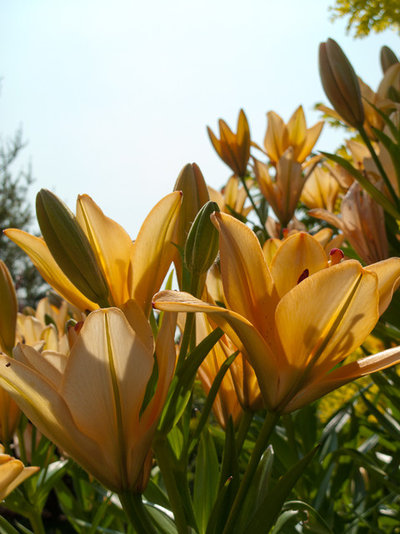
Le jardinet
3. Fill in with interesting vertical accents.
African Queen lily (Lillium 'African Queen') is the filler here; Oriental lilies are a fragrant garden highlight in mid to late summer. With each bulb providing multiple blooms over several weeks, you get a lot of punch for the dollar.
'African Queen' is one of the tallest cultivars, and its melon-colored trumpet-shaped flowers are truly stunning. Grow these massed in your border for best effect — they will continue to multiply each year.
USDA zones: 3 to 9
Water requirement: Average, but avoid soils that stay wet during winter
Light requirement: Full sun
Mature size: 5 to 6 feet tall
When to plant: Plant bulbs in spring, about 6 inches deep and with the pointed side up.
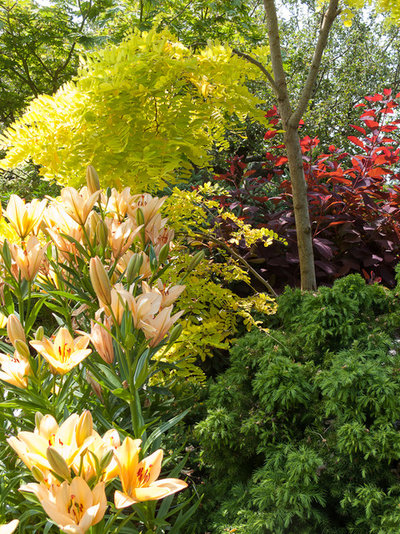
Le jardinet
4. Expand the combination if you like. Add color contrast and an additional layer by including darker foliage such as 'Grace' smoke bush, shown here. This will help to fill in between the golden locust tree and conifer while the lily grows and continue to add structure when those blooms have finished.
I have found that deer may nibble smoke bushes a little but rarely do significant damage. In such a dense planting as this, I would not anticipate a problem.
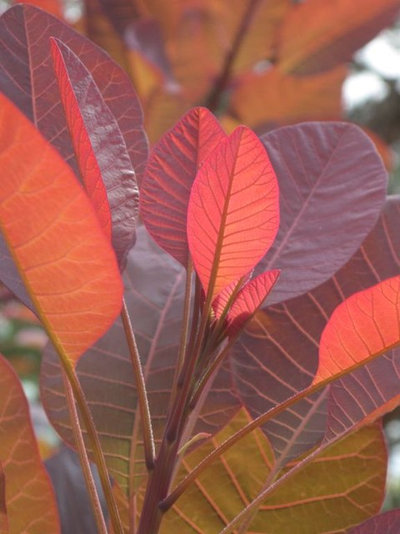
Banyon Tree Design Studio
Botanical name: Cotinus x 'Grace'
Common name: 'Grace' smoke bush
USDA zones: 4 to 9
Water requirement: Average
Light requirement: Full sun
Mature size: 10 to 15 tall and wide, but I like to cut it back hard in spring. This prevents flowering, produces larger leaves and keeps it around 8 feet tall and wide.
When to plant: Plant it in well-drained soil in spring or fall.

Le jardinet
By continuing to add layers of lush and colorful foliage, you can develop the combination to achieve the desired level of screening.
Deer disclaimer: The phrase “Deer will eat anything if hungry enough” is often quoted. Personally, I prefer to say, “Deer will eat anything if expensive enough.” Either way, the suggestions here are based on my own deer battles and those of many highly reputable references. Good luck!
More: What to do in your garden now





